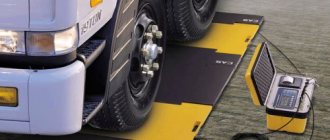Recently, two similar new products from the automotive industry quickly burst into Russia. One of them is domestically produced, and the second is Korean. What to choose - Lada vesta sw cross or Kia rio x line? Experts immediately made a comparison and noted that these models are direct competitors in many respects.
Car enthusiasts who dream of a passenger car with a fairly high clearance will now have to compare the Cross with the Rio car. Lada vesta sw cross is a new class B station wagon from AVTOVAZ, and Kia rio x line has become an updated version of the legendary Rio hatchback. Our review includes a comparison of the Lada Vesta SV Cross and the Kia Rio X Line. Read the article and figure out which car is right for you and your family - we hope this comparison will answer all your questions.
Body paintwork and metal thickness
Paintwork is the most important element of external protection for a car. The thickness of the paintwork, measured in neurons, is an indicator of quality. In different models of foreign cars, the spread of coating thickness ranges from 80 to 180 microns, and it varies in different parts of the car.
Lada vesta sw cross and the kia rio x line model have paintwork indicators of 120–135 and 138–173 microns. Russian new product Cross, available in 10 shades. For example, the spectacular bright scarlet metallic Mars. In the near future, the manufacturer intends to expand the color line.
The Korean Rio comes in 9 paint options, and the color scheme is bolder and includes, in addition to neutrals, Marina Blue and Sunset Orange. The Lada Vesta Cross, like the Kia Rio x Line in the new body, deserves all sorts of praise for the quality of the paintwork. Even places that are difficult from the point of view of the craftsmen - arches, internal compartments, bevels of doorways - are painted neatly and evenly. The relief of the paintwork (which is usually called shagreen), then it differs on plastic and metal parts. This is explained by painting technology.
Comparison of Lada Vesta and Kia Rio in terms of appearance
Both models make a pleasant impression, so it is quite difficult to single out a leader in this aspect. The competitors' exteriors are fast and modern, but executed with completely different strokes of the designer's brush.
Car interior
It is absolutely clear that the KIA Rio and Hyundai Solaris are actually twins in technical terms and have the same “parent”. The latter is aimed more at serious people over 35 years old, the first was created with an eye on the young and impulsive generation.
- The entire image of the car is permeated with “flowing” features. The Kia Rio radiator grille is shaped like the nose of a predatory animal, and the narrow optics create the impression of a sly look. The air intake is decorated with a chrome baffle, and buyers also appreciate the fog lights that complement the look.
- Looking at the profile, you notice a slight forward roll. The side panels are framed with stylish stampings. The chrome grabs the window opening without disturbing the mirror and adds some sparkle.
- The rear end completes the look with large and harmonious taillights, a sloping roof and a neatly integrated trunk.
Lada Vesta is not going to give in, as it has a completely memorable image:
- The aggressive and dynamic style consists of classic headlights, a powerful air intake and an equally colorful radiator grille with rare veins of chrome. This exterior attracts people of all ages.
- The wheel rims on the profile side, as well as the “X-style” stampings on the door, define the car as a standard of pressure and courage.
- The back part with its especially large fragments makes you more and more zealously riveted on this dynamic beauty.
Chassis and ground clearance
In Russian road conditions, cross-country ability plays a big role. Car enthusiasts compared the ground clearance of the Russian Lada and that of the Korean. The ground clearance of the cars is 203 and 170 mm. The brainchild of AVTOVAZ will easily overcome any curb when parking.
The ground clearance of a Korean car (170 mm) is not suitable even for minor off-road conditions - the ground clearance is not enough, and the front overhang is long. While tests of Vesta show: overcoming uneven ground at a speed of 40-50 km/h, the suspension cannot be broken. To be fair, we note that it still won’t cope with deep potholes; suspension repairs after a race on roads damaged by winter frosts will be inevitable.
As for the design features, both cars have a comfortable MacPherson strut suspension at the front, and an independent rear suspension with a torsion beam. The Russian manufacturer equipped the Cross with front disc brakes and installed drums at the rear. The Rio comes with the same set as standard, but for an additional fee you can buy a top-end version of the Korean with rear disc brakes.
Specifications
So far, the KIA Rio has an advantage in this regard, since the Korean model is able to offer the buyer a pair of power units, while the Vesta, which has three engines in a cage, is currently sold with only one. Both cars have common features in terms of the engine range - all engines are naturally aspirated, with an injection power system; there are no turbocharged units, as well as diesel engines, in the range.
Video: LADA VESTA // Part 2: in service. Vesta on a lift
The first Rio engine is a standard 16-valve engine with a volume of 1.4 liters. Despite its modest cubic capacity, it produces 107 hp. With. power at 6,300 rpm. And its traction is not bad - 135 Nm of torque at 5,000 rpm. Rio is not particularly fast with it, accelerating to hundreds in 11.5 seconds, but it can boast a top speed of 190 km/h. And all this with a consumption of 7.6 liters in city conditions. In addition, the Rio engine runs on 92 gasoline.
The 1.6-liter engine of the Korean sedan is noticeably more powerful. Its output is already 123 horses at the same 6,300 rpm. But the thrust not only became somewhat greater, adding 20 “newtons” (up to 155 Nm of torque), but its peak was also lower – 4,200 rpm. Acceleration with it is noticeably faster and takes 10.3 seconds. However, the change in characteristics did not affect the maximum speed - still the same 190 km/h. Consumption has increased, but not too significantly - up to 8.5 liters per hundred square meters (also AI-92).
So far, the Lada Vesta can only oppose the Korean with a Russian 16-valve VAZ-21127 type, with a volume of 1.6 liters. At 5,800 rpm it produces 106 horses, with 148 Nm of torque at 4,200 rpm. However, the advantage in the form of a lower peak power and torque in terms of dynamics does not give superiority even over the 1.4-liter Rio engine - 11.8 seconds. up to a hundred. This also applies to the maximum speed, which is limited to 178 km/h. And his appetite is higher - it reaches almost 10 liters in the city, and the AI-95 engine consumes it.
Another Vesta engine, the budget VAZ-21116, is a 1.6-liter 8-valve engine with a capacity of 87 horses. And the top one will be the 1.6-liter HR16DE-H4M engine, proposed by Alliance Renault Nissan, derated to 114 horses. But the exact characteristics of Vesta with them are still unknown. In addition, there is information about the development of a 1.8-liter VAZ-21179 engine. But it won’t appear under the hood of Vesta before the fall of 2016.
Therefore, in terms of power units, the KIA Rio has a noticeable advantage, for now...
In terms of transmissions, the Rio wins. Despite the fact that the cars have 2 transmission options, Rio has two manual transmissions and a pair of automatic transmissions. The companies' approaches to equipment vary. The Korean company took the classic route, offering fans a manual transmission in 2 versions (5 and 6 gears), as well as a pair of automatic transmissions (4- and 6-speed). Moreover, 6-speed gearboxes are available only for versions with a 123-horsepower engine.
Video: Lada VESTA vs KIA Rio.
AvtoVAZ took a different path. Vesta has only one manual transmission – a 5-speed, but there is no automatic transmission. Instead, there is a 5-band robotic transmission, which the Russian automaker preferred for the sake of greater savings. In addition, Tolyatti plans to install a continuously variable variator on Vesta.
In general, manual transmissions are equal - they turn on clearly, the lever does not fly out of the grooves, the force on it is adjusted (although not the standard), the strokes are quite short, and the gear ratios are chosen well. However, the presence of a 6-speed transmission in Rio allows it to be noticeably more economical, which is doubly valuable, since the top-end engine is significantly more powerful than the VAZ engine. But buyers and potential clients have different opinions about the robot - some think it is a very worthy unit, while others kick it for twitching in traffic jams. Of course, there are slight jolts when switching, but they are quite tolerable. The same 4-band automatic transmission in Rio is no better. But it’s hard for Vesta to compete with the top-end automatic transmission of the Korean sedan (6 gears).
Lada Vesta interior
The chassis design of the car is the same. They have MacPherson struts at the front, and a semi-independent design (torsion beam) is mounted at the rear. The Lada chassis is tuned to unexpectedly high quality. In motion, it is almost as good as Rio, and if you consider that Vesta’s ground clearance is 18 mm higher, which implies a different location of the center of gravity, then the result of the Russian car can be considered excellent. Vesta's driving qualities are at the level of competitors - clear and precise reactions to steering turns, slight sway at high speed, body roll that does not annoy the owner, etc. In addition, the chassis performs well outside the asphalt - long shock absorber strokes, softness, energy consumption and other trump cards appear in all their glory.
The Rio's chassis is preferable on asphalt - the sharpness of the steering is a little better, as is the performance of the brakes, and the tightness of the suspension is pleasing. But on a primer or broken surface, the KIA Rio is completely inferior to the domestic sedan - the struts more often work to break down, and all the irregularities are transferred internally.
Interior features
Steve Martin, chief designer of AVTOVAZ, has developed a stylish design for the Vesta Cross, which many like even more than the design of its Korean competitor. But in comparison with the comfort of the interior, the Lada Vesta Cross is inferior to the Kia Rio X Line: the lumbar support of the back of the front seat seems to be a good find, but the lower cushion is made too short.
Compared to Rio, the seat is more rigid and uncomfortable. And Lada passengers in the second row will be much more comfortable thanks to the large gap between the back of the seat and the knees. A characteristic feature of both models - a sloping ceiling - looks stylish, but a tall passenger will prop it up with his head.
The quality of the interior and its equipment is inferior to Vesta: a rather harsh steering wheel, stiff window lifter buttons. Data from the speedometer scale is difficult to read. The steering wheel has pleased car enthusiasts - it is conveniently adjustable in terms of inclination and reach. Both models have curtain airbags on top trim levels.
Vesta offers seat upholstery in black + gray and black + orange. Kia has a color combination: black + red. The Korean's interior materials are better in appearance than those of the Russian station wagon.
Exterior
It is impossible to identify a leader here. Both cars are designed with speed and style, but the way they implement this concept is different.
It's no secret that the KIA Rio and Hyundai Solaris are essentially twins, especially in technical terms. But if Hyundai is aimed at sedate buyers over the age of 30, then Rio was created with an eye on the youth audience. This determined its design, made in the style of “flowing lines”. A tiger-nose radiator grille, long and narrow headlights, an air intake with a chrome baffle and fog lights are what attract buyers.
It's hard to resist such a car!
The profile of the car is slightly inclined forward, there are spectacular stampings along the side panels, the chrome of the window opening adds ambiance, the roof is slightly tilted back, and the rear, with its large lights, is very harmonious. All this merges into a modern and fresh image that attracts young people so much.
Harmony in the image - it is not surprising that many choose Rio.
Lada Vesta, however, is in no way inferior. But in it, sophistication is replaced by aggressiveness. Classically shaped headlights, an air intake and a radiator grille, combined together with the curve of the chrome lines, create the image of a modern sedan. Moreover, this appearance will suit any buyer, regardless of age.
A powerful front end is Vesta’s trump card!
The profile is no less impressive. You just have to look at the X-shaped lines of the panels and the rims to immediately fall in love with this car. But the stern didn’t disappoint either – the straight lines of the lights look great against the background of the chrome-plated LADA letters.
But the profile of the Lada is no worse.
Warranty
Sales of the new Rio X Line began in 17, and should grow in 18. The warranty for a new car is 100,000 km or 3 years. But the warranty period for individual structural units and parts will be shorter (for example, for batteries and shock absorbers - 2 years).
But the Korean manufacturer gives a guarantee for Rio of 150,000 km, or 5 years. A scheduled inspection is required every 15,000 km, but this interval may be reduced if the car is used very intensively, for example, as a taxi. Warranty service, according to reviews from car owners, is better provided by a Korean company.
Reviews about the trunk
The luggage compartment volume of the X-Line is 390 liters. But the Russian Cross station wagon surpasses it in trunk volume (480 l) and in functional equipment. Three grids plus a practical organizer in the trunk of the Vesta cross are very convenient. They securely secure cargo during transportation. Under the false floor (niche for the spare wheel) 95 liters of additional volume are hidden.
To transport large cargo, the rear seat can be folded, the total volume of free space will reach 825 liters. The double floor is divided into sections, each can be used separately.
Two wide handrails on the Lada Cross allow you to quickly close the trunk, while the Kia is equipped with only one handle.
Engine and gearbox features
Let's compare the engine and gearbox of two cars. The Korean car is equipped with gasoline engines (two power options to choose from - 123 and 100 hp). Cross engines have similar parameters (106 and 122 hp). Acceleration dynamics are 10-13 seconds. and 11-13 sec. accordingly (the range of values is due to the power unit).
The Rio hatchback from Korea optionally offers a six-speed automatic transmission. And the Russian Cross station wagon with automatic transmission is equipped with a robotic clutch. This robot, which was introduced in previous AVTOVAZ models, performed poorly in road conditions: the gas pedal does not respond immediately, and the automatic switches gears for quite a long time. Any maneuver on the highway requires experience and enormous concentration, as you need to adapt to the slowness of the transmission.
Thus, for those who love a dynamic, psychologically comfortable driving style, it is better to get a model with a manual transmission.
What is the final result?
The domestic car model is capable of not only competing with its Korean counterpart on an equal footing, but in some cases even significantly surpassing it. It is worth considering that AvtoVAZ always listens to its consumers. For this reason, it is quite possible that in the near future those nuances that cause some dissatisfaction will be finalized. Before the sedan appeared on the country's automobile markets, it was redesigned more than twenty times.
Moreover, do not forget about the cost of cars. Vesta with a 122 horsepower unit will cost only 633 thousand rubles. For a Korean car assembled in St. Petersburg, you will need to fork out 767 thousand rubles. Whether it is worth giving that kind of money is definitely up to the buyers to decide.
Prices and options
The two cars we are comparing are made according to different packaging principles. Vesta, even in its initial configuration for 780,000 rubles, has a large range of options: cruise and climate control, snow and rain sensors, parking sensors, speed limiter, navigation, rear view camera, 4 airbags.
While Kia offers this entire set of options only for 960,000 - 1,024,900 rubles in the maximum configuration. The manufacturer did not provide cruise control and a rain sensor function in the model, but offered a heated steering wheel and 6 airbags. We can conclude: when buying a Lada Cross, the consumer will receive more functions for less money.
conclusions
From the point of view of the development of the Russian automobile industry, Cross can be considered a definite breakthrough. The station wagon model is not very popular in Russia yet, but has great potential.
The Kia Rio X Line is superior to the Russian Cross due to its high profile tires and automatic transmission. But the AVTOVAZ model has greater cross-country ability due to its ground clearance, and will also attract consumers with a spacious interior and ergonomic trunk.
Comparing prices and configurations, it can be argued that the Cross is more economical than the Korean. But, looking into the future, we also need to evaluate maintenance and the warranty period, which the Korean has longer.











